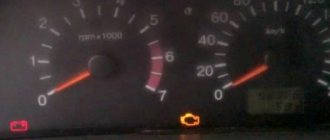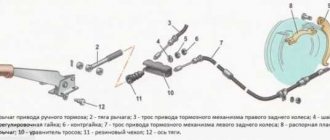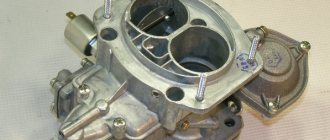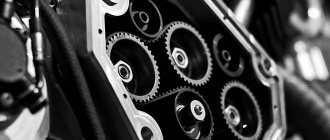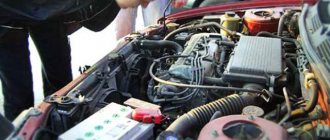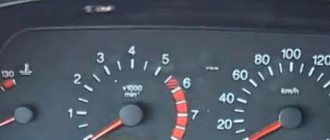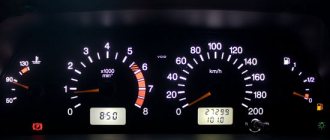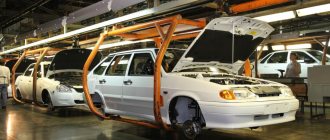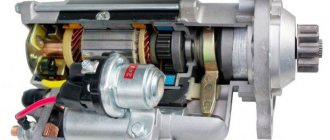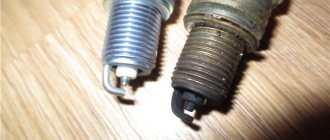Many have encountered this problem before, but some have not yet. But, as practice shows, sooner or later this happens to any Chevrolet Niva. The turnover is starting to move. Sometimes while driving, sometimes at a traffic light, idling, sometimes the car stops and then starts, and sometimes it doesn’t start. You don't really have anything to worry about, but you don't need to forget about the problem either. It won't work alone.
The symptoms are such that it is usually immediately obvious that the problem is electrical. If you operate the accelerator pedal, the car reacts normally, the engine runs, i.e. there are no problems with the supply of fuel and air. There are no extraneous noises either. But the speedometer needle may suddenly, after filling with gas, not return to normal, but freeze at 2 - 2.5 thousand revolutions or, on the contrary, drop to zero. Sometimes the engine idles at 700-800 rpm and “barely breathes.”
These sensors are one of the most common causes of this engine behavior.
1. If the speed fluctuates while driving and idling, the tachometer needle is usually below its normal position. If the car often stops at idle and, with the air conditioning on, sometimes freezes when changing speed, then with a 99% probability it is the idle speed sensor. The most interesting thing is that when I first came to the electricians with this problem, they offered me diagnostics for almost 2000 rubles, and only then I began to look for what the problem was. I refused. IMHO it's a scam. I called the officials, they also only offered diagnostics. He also refused. In the end, I just went to a friend’s car dealership, he diagnosed me with a problem with the sensor, although it wasn’t cheap, but at least it would remain for later; if another problem arose now, he went to buy it. The engine worked as it should. And then I read somewhere that the diagnostics did not show a problem with DHH. The throttle shows that the corners are not holding them, but the DHX does not detect this. Money on diagnostics will be wasted!
By the way, if the car stops when you try to start it, you can still drive. Accelerate the pedal and keep it pressed so that the speed does not decrease. While driving, try to change gears and brake very quickly without pressing the clutch. Stand at a traffic light with the handbrake on. But this is one way to get to a service station or garage without a tow truck. The most difficult situation is braking down a hill. You need to brake and throttle at the same time. Avoid such places.
And so, you can fix it on the road.
2. If your number of revolutions fluctuates and when you release the gas, the needle is in no hurry to return to the normal number of revolutions, or starts to move up and down, and you are ashamed to stand at a traffic light, because everyone thinks that you are a brainless shnivognik, run and jump from the traffic light)) So that your problem is most likely with the throttle position sensor.
Both sensors are available for replacement. All you have to do is wait until the engine cools down to avoid burning your hands. The replacement itself is simple, unscrew the old one, screw on the new one. The electrical connector is such that it is incorrect to connect it. When you first start the engine, the speed usually increases. But if you turn it off and on again the engine will work fine.
Of course, there are other reasons for unstable engine operation, but it is more difficult to find problems there. In any case, it is better to replace the sensors first.
Why does the Niva freeze when idling? Let's figure it out.
Signs of malfunction of the Chevrolet Niva idle speed control and where it is located
In commonly used terminology, there is always an error in the name of this device, which sets the engine speed when the gas is released, that is, when the throttle valve is completely closed.
It is called a sensor, although, of course, it is not a sensor at all. The Chevrolet Niva idle speed control (IAC), as on all other cars, is an actuator in its principle of operation. Let's consider the reasons for the appearance of this device in the injection control system, the principle of its operation, characteristic signs of malfunctions and methods for finding them. A driver who understands this will be able to independently fix a significant part of the problems in the power system.
conclusions
Knowing the reasons why a car may be idle, you can identify and eliminate them yourself. If you don’t have such skills, then you need to go to a gas station.
The idle air regulator is a special device that regulates the air supply. It is made in the form of a conical valve driven by an electric motor. It is controlled by the ECU, which determines the required channel opening level.
The Niva Chevrolet idle speed control is non-separable, so if problems arise with its operation, it must be completely replaced. Disassembly is somewhat difficult as the throttle body must also be disconnected to remove the regulator.
Principle of operation
The mechanism of action of the device is the sequential execution of a standard program. The entire triggering process can be considered step by step. It will be easier to build a situation when the engine is running, warmed up and fully operational.
- The driver releases the gas pedal while driving.
- The next stage is the closing of the throttle channel, the flow of air into the engine stops.
- This is where the sensor comes into play. The on-board computer sends a signal to the stepper motor (a total of 255 pulses can be sent, each one moves the valve a certain distance).
- Using the DPKV, the on-board computer determines the number of engine revolutions and, if necessary, opens or closes the passage hole.
Please note that the device does not have feedback from the ECU. In the body of the part there are only two pairs of contacts responsible for moving the rod and its positioning in space.
A trip to the workshop
As you can see, everything described above can be done by a person who knows the structure of the car, but there is nothing for a beginner, because not every novice car enthusiast knows where the XX valve is located, much less its sensor. There is a high probability that outside interference will only make everything worse, or will break or spoil something that was originally in working order. So here it’s worth setting priorities and logically assessing your chances of correcting all problems yourself.
Naturally, in moments when the car stalls when releasing the gas, few people are interested in why this is happening, so it would be very advisable to call a tow truck and tow the car for repairs, or, if the situation is not completely dire, then you can drive to the repair shop yourself .
The price for correcting problems will directly depend on their cause; if it is a simple flushing of sensors and valves, then it will not be very high.
Many car owners have experienced a situation where the engine stalls when releasing the gas. This problem is very common among many machines. And sometimes such a situation can catch the owner at the most inopportune moment. Therefore, you need to know how to deal with such a breakdown.
Procedure for removing the device.
To remove this device, you need to stock up on a small set of tools, consisting of a 13mm socket wrench, a screwdriver and pliers.
- Place the vehicle on a flat surface and secure it with the parking brake. If there is any doubt about the stability of the car, you need to install wheel chocks.
- After this, you need to disconnect the battery terminals.
- We unscrew the fastening nuts and studs that secure the receiver to the throttle valve. In this case, there is no need to disconnect the pipes of the cooling and crankcase ventilation system.
- Disconnect the terminals from the wires
- Using a Phillips screwdriver, unscrew the valves on the throttle valve
- When the device mount is unscrewed, you can remove it from its seat. Usually, you can get the O-ring along with it. But, in some cases, it may get stuck in the damper well.
- In this case, it is necessary to carefully dismantle it.
But sometimes the device may be working properly, but problems in operation are associated with its clogging. In this case, you can try cleaning it with carburetor cleaner. Typically, this method helps to revive a device that has no visible mechanical damage. But this measure does not guarantee a 100% result, but is only temporary, which allows you to get to the nearest service station or store with spare parts.
The idle speed of the Chevrolet Niva may be incorrectly adjusted if the sensor has increased travel between the valve and the supporting surface. When measured with a caliper, this distance should not exceed 23 millimeters.
Compliance with these parameters is necessary in order to ensure correct installation and not damage the throttle body.
Before installation, the seat must be cleaned. You can also lubricate the O-ring with engine oil to make it easier to put it in place.
Auto parts for foreign cars, auto repair
You can check it by installing a working relay. You can determine the lack of contact on the main components of car parts by visual inspection. It is necessary to tighten the contacts on the starter, the injector power supply and the fuel pump. The positive wire that powers the electronic injection system comes directly from the battery terminal with a separate wire. Often the problem with the immobilizer can be a low battery. You just need to install a new battery.
This is to clarify the Chevrolet Niva is difficult to start when cold due to a fault in the electrical part of the car, but do not forget about mechanical damage: The indicator on the instrument panel will help you find out if there is no fuel in the tank.
If the fuel gauge is at zero and the warning light in the form of a gas pump is on, then the source of the trouble has been detected and there is no need to open the hood. You can determine if a filter or fuel pump is faulty by hearing.
If you hear a loud buzzing sound in the rear trunk area, the filter or pump is most likely clogged, preventing fuel from getting to the engine. It indicates any damage to the injector or engine error. If the oil level in the car has dropped, this can be determined visually using a warning lamp in the form of a can on the instrument panel. If your Chevrolet Niva doesn't start well when it's cold, make sure there is enough oil in the engine, pull out the level meter and check.
Troubleshooting Having identified the problem that causes the Chevrolet Niva engine to start poorly, you can begin to fix the problem. Knowing the source of the problem, you can draw the appropriate conclusions: Most of the above reasons have a simple nature of damage, and fixing a Chevrolet Niva that doesn’t start well when cold won’t take much time.
A list of the main malfunctions when the engine does not start or starts poorly, and how to eliminate them. You can light a cigarette from another car, then the generator will recharge the battery. Clean the contacts if they are oxidized and lubricate them with Lithol. The lubricant prevents the appearance of oxide on the terminals. Tighten the terminals well to get good contact. Starter Check the starter contacts and tighten them.
In the case of a Chevrolet Niva, it is difficult to start when cold, have the starter repaired to rewind the windings, or install a new one.
Spark plugs Replace all 4 spark plugs with new ones, or clean them with sandpaper. But in any case, if the spark plugs have worked out, they need to be changed so that there are no problems with the engine.
Refuel only at branded gas stations, and only with fuel that is suitable for this type of engine A Fuses Install new fuses.
4.27.2 The engine runs erratically or stalls at idle
The engine immediately stalls, but then the idle speed control starts. Here the reason may be in the firmware of the electronic engine control unit.
The engine of a fuel-injected VAZ car stalls
The reason for this may be improperly performed tuning of the power unit. In this case, the engine will operate stably only at high speeds. This malfunction can be eliminated by flashing the unit to the factory version of the program.
You should also pay attention to all kinds of sensors in car systems. These are, for example, the idle speed control, the throttle position sensor and others. They need to be checked at stands.
If a carburetor is installed on a car, then in 4 cases out of 5 it can be the cause of unstable engine operation. The most common problem is that the carburetor is clogged.
Although this unit is considered reliable in a car, it should also be cleaned periodically. It must be washed using special solvents that are sold in the store.
So I’m moving from 95 to 92 to reduce the amount of additives, and therefore this residue that clogs the filters. Its price is cheap.
Maybe the fuel pump itself is faulty. It overheats and does not create the required pressure.
In principle, the Ministry of Health cannot completely die. When it warms up, you give the gas harder, somewhere somewhere it clicks and breaks through, and 2 cylinders stop working normally..
Hence the immediate failure.. The feeling that when you add gas, it’s as if a truck was added on a tie. The MH is located directly on the block, hence its heating.. If 2 of your cylinders are not working, then the engine should start to wobble. And under such conditions, the engine should warm up, as the load increases.
This happens when you sit in a snowdrift or in the sand. Maybe this is the “sausage” of the engine, I don’t know..
I bought an ignition module, the price is rubles. The engine temperature is 99 degrees, the second fan turns on, the engine runs quietly, the speed increases as it should, acceleration is standard. With the transition to “92” fuel, I didn’t notice any special changes, only the engine seemed to run smoother.
The problem has not yet manifested itself, I’m waiting for the next trip over a long distance and I’ll check it. To begin with, I installed the old explosive wires, then replaced them with a spare working MZ. There is one very sensible one, where a competent participant explained the reasons for a similar malfunction to another. I eliminated the explosive wires by replacing them; before installation, I checked the spark plugs on a Soviet-designed pressure apparatus. In addition, I unscrewed the spark plugs and inspected them: Well, I started. Of course, everything is very useful for the car as a preventative measure.
My brain did not stop analyzing, I annoyed everyone I knew with my calculations, and re-read the forum topics five times.
Complete sabotage
The most deplorable situation, the engine does not start at all.
First of all, you need to maintain composure and not scold the car itself. Only after this, we calmly begin to find out the reason why the engine does not start.
Do not allow the battery to be severely discharged by pointlessly rotating the engine crankshaft, the energy will still be useful to you, but where you will charge the battery if you are far from home is the question. Although for the electronic unit itself 8 Volts will be quite enough. But, of course, they won’t be enough for the starter.
When you have calmed down, be sure to check:
- How does the fuel pump work and is there any fuel in the tank?
- Is there ignition?
- Is the engine crankshaft timing sensor functioning?
- Have the injectors failed, although the failure of several injectors at once is too much, this happens very rarely.
- The ECU is working. But this device also fails very rarely.
The engine idles unevenly: reasons - Engine Master
The Niva Chevrolet SUV has an engine as its heart, and in order for it to work efficiently and its productivity not to decrease, it is necessary to monitor the health of the air and fuel systems, and if the engine does not idle smoothly, then first of all you need to look for the reason in these two systems.
Interruptions may be associated with failure of such parts as:
- electric pump
- injectors
- as well as spark plugs
- 1 Problem solving
- 2 Condition of spark plugs
Rough engine idling - causes and malfunctions
» Engines » Rough engine idling - causes and malfunctions
Troubleshooting Methods
You can solve problems with jumps and floating speeds yourself:
- To confirm and eliminate the possibility of air leaks from the outside, check the supply system for leaks. Using a compressor or pump, supply air to the removed hose placed in water. This allows cracks to be detected.
- The resistance of the IAC is measured. Values within 40-80 Ohms indicate that the device is not working.
- During the diagnostic process, the crankcase gas ventilation valve is cleaned. It is removed and washed with kerosene or carburetor cleaner.
- When sensors fail, they are not repaired, but replaced immediately.
- If the throttle valve requires washing and removal, it is recommended to entrust the job to a specialist. Without removing the damper, you can wash the part yourself using a cleaning aerosol.
- Adjust the idle speed by setting the “quantity” and “quality” screws on the carburetor. Clean the nozzle with an aerosol and blow it out with compressed air.
In most cases, eliminating these causes helps to get rid of floating speed.
Engine temperature sensor
If the device breaks down, the dashboard provides incorrect data regarding the engine temperature. To check and change the temperature sensor, proceed according to the following algorithm:
- Prepare an autothermometer for working with high temperatures, a tester and a metal basin with water for heating on the stove.
- Disconnect the connectors and, substituting the basin, remove the sensor from the socket. A plug is placed in place of the sensor.
- The device is placed in cold water with the side screwed into the cylinder head. Measure the resistance and put the basin on the gas.
- Measurements are taken several times at different temperatures and compared with the standard data in the service book.
Significant discrepancies indicate the need to replace the temperature sensor with a new one.
Source
Replacing the low speed regulator on Shnivy
To change the device on the machine, follow a simple sequence.
- Park the car in place and let it cool. Working with a hot engine is inconvenient and dangerous - heated blocks can burn your hands.
- Remove the terminals from the battery.
- In some cases, to ensure complete tightness, craftsmen coat the connecting layer with varnish. Therefore, the throttle valve must be removed entirely and only then the regulator must be dismantled.
- Remove all pipes and hoses from the remote control, having first disconnected the electrical power.
- The last step is to remove the sensor. Two screws are unscrewed and the module is removed.
- After this, you will need to clean all surfaces and channels from dirt, carbon deposits and possible oxidation.
- Installation and subsequent assembly are performed in reverse order.
You can also watch the video on how to replace parts.
How to clean
Often the cause of device failure is contamination. The ingress of dust and the formation of oxides can interfere with signal transmission. Typical cleaning looks like this:
- The contact group of the regulator is opened and the contacts are wiped with a cotton swab dipped in alcohol. This will help remove oxidation and increase network conductivity.
- If the sensor is covered with oil, it should be removed and washed with alcohol. The shut-off valve and spring are additionally processed.
View topic
On a working engine control system it is equal to 7 degrees. Now we need to understand what leads to changes in SOP?
In the first case, there was an air leak, which I discovered using a Leak Check fog machine. Malfunctions along the way Updated It is necessary to find the malfunction and, if possible, eliminate it.
Start the engine and let it idle. Go to the exhaust pipe and listen to the sound of the exhaust.
You can bring your hand to the cut of the exhaust pipe - this way the interruptions are felt better.
Troubleshooting electrical wiring
So, if the actions described above do not bring results, you need to start troubleshooting and directly repairing the electrical wiring.
Troubleshooting involves dividing all electrical wiring into separate sections. To know how electrical wiring is divided into sections, it is advisable to have a wiring diagram on hand.
A small example of electrical wiring repair in a private house
Initial data: Let's say the sockets and lighting in the kitchen and bedroom do not work.
Cause of malfunction: Wire-2 is damaged (but we don’t know about it yet).
We will divide the electrical wiring repair into several stages. First, you need to check the power in distribution box No. 2, since it is from it that the kitchen and bedroom are powered.
Let's open this box and take a look. The connection points of the wires must be intact, not torn (burnt off in case of a short circuit) and in good condition (without melting of the wire insulation). If necessary, we press the twisted wires for better contact (if twisting was used to connect the wires).
If there is no visible damage in the box, after inspection we check for the presence of voltage at the junction (twisted) of wires 1 and 2 (box No. 2). There must be tension! If it is not there, then the problem is poor contact.
Let's move on, now we need to check whether voltage is coming to junction box No. 3. To do this, open it and also use a pointer to check the presence of voltage on the conductors of the wire. No tension! This means the problem is in the wire (for example, it was damaged by an electric drill when installing the picture).
To finally make sure that the wire is damaged, you need to check its integrity. To do this, we turn off the machine at the entrance to the house, unscrew wire 2 on both sides (in the distribution box No. 2 and No. 3) and use a “dialer” to check the wire strands for integrity.
In this case, there are three ways to solve the problem with a damaged section of wire:
- . Remove the damaged wire and install a new one in the wall instead. To do this, you need to trench a section of the wall with a damaged wire;
- . Lay a new one over the damaged wire in an open way in the cable channel (open wiring).
- . If, when installing electrical wiring, a three-core wire was initially laid, and there is no grounding in the house, then you can use the third core as a working one (this is provided that one of the cores in the non-working wire is damaged).
If there is no electricity in the entire house, then first of all the presence of voltage is checked at the input circuit breaker. If the circuit breaker is working properly, the voltage will be both at the input and output of the circuit breaker (of course, in the on position of the latter), and then proceed according to the above diagram.
Electrical wiring repair tool
The main tools for repairing electrical wiring are:
- - voltage indicator or multimeter to check voltage;
- - pliers with insulating handles - for twisting wires in the junction box;
- — a screwdriver in case the terminal clamps of protective devices (automatic machines, RCDs, etc.) are unscrewed or tightened;
- - PVC insulating tape - for insulating exposed parts of the wire after twisting.
There is another irreplaceable parting that every electrician should have - a “diagnosis”. This device consists of a regular battery, a light bulb, connecting wires and clamps. All these elements are connected in series to each other. Making it is not particularly difficult.
Using a “continuity test” you can easily check the wires for integrity. Especially with hidden electrical wiring.
Diagnostics of DXX
Often, problems with the idle air control valve are confused with a breakdown of the throttle position sensor. A distinctive feature is that the “Check Engine” indicator on the dashboard lights up in the event of a failure of the throttle position sensor.
The following signs indicate a breakdown of the idle air regulator:
- strongly floating speed when starting the car;
- when the heater and headlights are turned on, the revolutions drop below 500 per minute;
- If the car has not been driven for a long time when the ignition is turned on, the engine runs at low speeds without warming up.
If at least one point matches, it is necessary to check the DXX.
To check the functionality, measure the voltage supplied to the regulator:
- The Chevrolet Niva is placed on a level surface and the parking brake is raised.
- The terminals are removed from the IAC.
- Using a multimeter, connect the connectors alternately.
- Turn on the ignition and look at the tester values.
- Normal voltage is considered to be 12 W. Indicators less than 12 indicate a low battery.
- If there is no voltage, check all wiring for an open circuit.
- Test the resistance at the IAC outputs one by one. In good condition it shows 53 ohms.
If the regulator fails, then it is replaced with a new one:
- the car is put on the handbrake;
- remove the negative terminal from the battery;
- unscrew the nuts from the throttle studs without disconnecting the pipes;
- remove the terminals from the idle speed regulator;
- unscrew the screws securing the car sensor;
- take out the device.
The new device is assembled in the reverse order.
Injection engines
The listed reasons for increased idle speed apply to carburetor engines. But many of them make themselves felt on injectors. However, in the second case, problems with electronics are added to the list of problems. High idle speed on injection engines is explained as follows:
- Incorrect setting or damage to the antifreeze temperature control sensor. If the unit fails, the engine will succumb to constant warming up, which will not allow it to freely drop speed. This is due to the fact that the control unit does not receive any information (or receives it, but incorrectly) about the current degree of heating of the power plant, so it will try to heat it. In addition to uneconomical fuel consumption and high idle speeds, the problem can cause a more serious problem - overheating of the engine with subsequent failure. In this case, you will have to carry out complex and expensive repairs to the unit. To determine problems, just use a diagnostic scanner.
- Damage or malfunction of the throttle position sensor. This element is one of the most important in all injection engines. If it supplies the ECU with incorrect data indicating that the throttle is opening, the speed will constantly increase. The problem is caused by jamming or complete damage to the part.
- Damage to the return spring or problems with its operation. As the vehicle is used, the return spring may stretch or jump out of place, which will lead to the problem in question. You can restore the previous state through your own efforts.
- Throttle cable sticking. The defect appears in older car models, for example, VAZ 2107, 2109, 2110, etc., and is solved by simply replacing the cable or applying lubricant to the existing part.
- Damage to the sealing gaskets on the injectors. It is very difficult to determine such a breakdown, and during maintenance it is carried out last. If the gaskets are damaged, additional air enters the combustion chambers, which increases the speed.
You may also be interested in: How to properly wash an engine with your own hands
Carburetor models
The era of carburetor-type engines has long come to an end, so it is very difficult to find them under the hood of modern cars. However, there are people who are not going to abandon the domestic automobile industry and turn to car services with a complaint that their VAZ-2109 stalls at idle.
Injection engines have long occupied a leading niche, and it would be logical to become familiar with the reasons for high idle speeds in the presence of an injector, but most of them have something in common with carburetor engines. Therefore, first of all, you need to understand why the speed increases on old power plants with carburetors. The following factors can lead to this:
It will also be interesting: Instructions for washing injectors and injectors with your own hands
- Incorrect system adjustment. If the idle speed control unit has been adjusted incorrectly, which often happens after routine carburetor repairs or cleaning, a problem with high speeds is inevitable. Also, when servicing a car independently, many drivers choose the proportions of air and fuel incorrectly, and this is also a serious mistake.
- Damage to the throttle valve. If there is a loss of sealing of this element, the risk of increasing idle speed will be maximum. Often the throttle valve stops working normally due to carbon deposits appearing on it. Therefore, experts advise cleaning the part. And if it was seriously damaged, for example, cracked, then you will have to replace it. Such an event can only be implemented on some carburetor engines.
- Needle valve position. With this problem, the fuel chamber will receive incorrect portions of the fuel-air mixture.
- Burnt out cylinder block gasket. The problem can be resolved by simply replacing the gasket. To make sure that a part has been damaged, it is enough to check its condition while the engine is running. If white smoke starts coming out after opening the hood, it means the gasket needs to be changed.
- Open suction. The malfunction is diagnosed by checking the quality of operation of the damper in the primary chamber. If failures were detected at the inspection stage, all that remains is to look at the operation of the choke. In most cases, the problem is solved simply - the motorist needs to lubricate the damper drive and cable.
